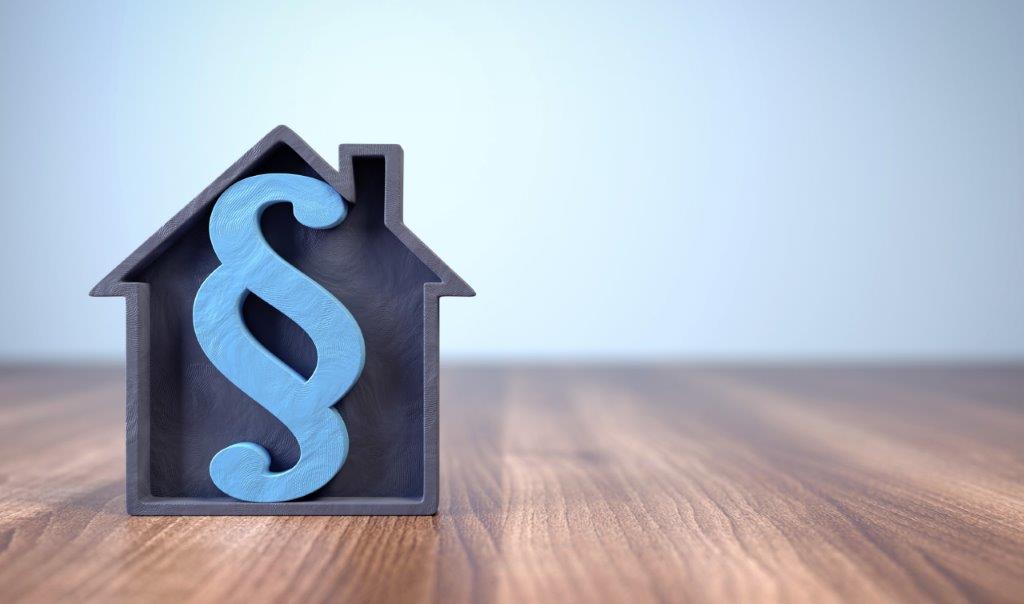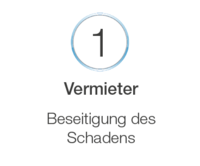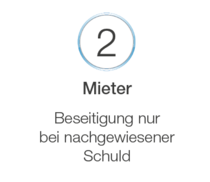Tenancy law and rent reduction in the event of mold growth
Mold in rented homes is a widespread problem and can be costly. Estimates assume that almost every 10th household in Germany is acutely affected by mold. For house and apartment owners, the question of how mold can be permanently removed arises when it comes to mold. If it is not a secondary infestation and the cause can be traced back to structural defects, this can mean expensive renovation measures.
If the property is rented out, the question of whether the tenant or the landlord has to pay for the costs of cleaning up the mold in the rented apartment can be complicated. The party responsible for the mold infestation is responsible for assuming the costs. However, it is precisely this fact that often has to be clarified in court. This guide aims to present and explain important principles of tenancy law on mold infestation and give advice on how to proceed in the event of existing mold infestation.

The information given here is only intended to provide an initial overview and does not replace specific legal advice in individual cases!
If there are any doubts about the existing legal situation and the existing rights and obligations, tenants and landlords should seek advice at an early stage. An overview of possible advice centers can be found here.
Rights and obligations of the tenant at a glance
- The tenant is obliged to take suitable measures to prevent mold growth
- The living behavior must be adapted to the living conditions to a reasonable extent
- There is an obligation to adhere to the agreements in the rental agreement if these have been approved
- The tenant is obliged to report mold growth to the landlord immediately
- If there is serious mold growth that is not your own fault, you have the right to a rent reduction


- Construction defects do not have to be compensated for by excessive heating and ventilation by the tenant, furniture can be placed in any way
- In the event of structural defects, the landlord is liable for the damage
- The tenant is obliged to avert damage to his own person, otherwise claims for damages expire
- In the event of mold growth that is not at fault, the tenant has the right to terminate the contract without notice
Tenancy law in the event of mold in the apartment
When is the landlord liable for mold growth?
If the mold growth is clearly due to structural defects, the renter is fully liable for the damage. These can be cracks in the masonry, water damage from defective pipelines, leaky roofs or wall cladding. Even after an improperly carried out (energetic) renovation, the landlord is responsible. If the landlord has the apartment refurbished in terms of energy, for example by installing new windows or thermal insulation, he is obliged to inform the tenant whether this refurbishment means heating and ventilation behavior that is adapted to the tenant.

If the landlord does not comply with this duty of disclosure, the tenant cannot be held responsible for the damage. Furthermore, the tenant cannot be held responsible for mold caused by new building moisture, as the tenant cannot be required to compensate for the new building moisture through extensive heating and ventilation. The tenant can only be held responsible for non-compliance if specific heating and ventilation behavior is anchored in the rental agreement. Since 2009, a ventilation standard (DIN 1946-6) has stipulated that in new buildings and renovations (with more than a third of the windows being replaced) adequate air circulation must take place in the rooms without the assistance of the tenant.
When is the tenant liable for mold growth?
If the mold infestation cannot be traced back to structural defects, but rather to incorrect living behavior on the part of the tenant, the tenant is liable for the damage caused by the mold infestation. Insufficient heating and ventilation will increase the humidity in the apartment and mold will develop. Indoor plants, aquariums, terrariums that are too wet or drying clothes in the apartment favor mold growth, which is why living habits must be adapted to the circumstances of the apartment. Removing splash water from tiles after showering is also a tenant’s responsibility.

However, what “appropriate living behavior” means in detail in order to avoid mold has not been clearly clarified by the courts either. There are no specific rules as to how often and how long you have to air the room during the day. While some dishes consider ventilating twice a day for a total of 20-30 minutes as sufficient, other dishes consider ventilating two to four times for around 10 minutes each time as reasonable. However, the courts agree that tilting the window does not mean adequate ventilation, as this does not result in a sufficient exchange of air. The courts also disagree about the appropriate room temperature.
However, there is consensus that the room temperature must not fall below 16 ° C. If the heating and ventilation to prevent mold exceeds a normal level due to special requirements of the apartment, this must be regulated in writing in the rental agreement. The tenant is not obliged to adapt his living behavior to the living conditions to an extent that is no longer justifiable. Only if he specifies such living behavior in an individual agreement can he be held liable in the event of mold growth. The tenant cannot be held responsible for incorrectly set up furniture (too close to the outside walls), as the living conditions must be designed in such a way that the furniture can be set up on the outside walls without any problems.

How should tenants proceed in the event of mold growth?
What to do if there is mold
If the tenant notices mold growth or moisture damage in the apartment, this must be documented and the landlord must be informed immediately, because the tenant is obliged to report any rental defects. Only if a notification of defects (§536c BGB), which names the defects and requests the landlord to rectify them, is submitted to the landlord, the tenant can enforce his rights. These can include the elimination of defects, claims for damages, termination without notice and a reduction in rent. If the notification of defects is submitted too late and the mold has spread further in the meantime, it may happen that the tenant is complicit in the mold in question and he has to bear part of the costs of the damage.
If the landlord is aware of the mold, he is fundamentally obliged to repair the damage. Often tenants and landlords do not agree on who is responsible for the mold and who pays for the renovation. If the landlord refuses to accept the damage because he sees the tenant’s culpable behavior, it is not necessarily necessary to go to court. First, an attempt should be made to reach an out-of-court settlement between the tenant and the landlord.

If the tenant wants to make sure that the mold infestation cannot be traced back to their own misconduct, hiring an appraiser is an effective means. Ideally, both parties can agree to commission an expert to determine the cause and thus responsibility for the mold infestation. It is essential to clarify in advance who will pay the appraiser. It should be noted that the result of the expert opinion is not legally binding and cannot necessarily be presented in court, because courts appoint their own experts. For this reason, tenants should think twice about appointing an appraiser on their own, because the money is usually not returned even after winning legal proceedings.
Rent reduction in case of disputes regarding the mold in the apartment
If no agreement can be reached with the landlord, it is possible to reduce the rent independently in order to get the landlord to act. However, there are some risks involved in doing this. If the rent reduction is not justified, i.e. the tenant is responsible for the mold, the landlord has the right to terminate the tenant without notice if the rent arrears exceed two months’ rent. This case law goes back to a court decision from 2012. In addition, the rent arrears must be paid. If the tenant is certain that the landlord is to blame for the mold infestation based on a self-commissioned report, the means of rent reduction in the case of mold is an effective instrument, but even then there is a residual risk. It is better to point out in the notification of defects that a certain part of the rent will be paid under reserve until the mold has been removed. If the tenant gets right in later legal proceedings, he can get this amount and get the money back.


If the landlord cannot be induced to act by this measure either, the case can only be clarified in court. A specialist lawyer should then be consulted in advance as to which is the best course of action. It is important that all necessary documents (correspondence with the landlord, photos, etc.) are available and available to the lawyer. Responsibility for the mold infestation is clarified in court at the latest.

Court decisions in the event of mold infestation - reduce rent in the event of mold
If a tenant asserts his or her right in court, the court must clarify who is responsible for the mold infestation. For this purpose, the court appoints an expert who examines the conditions on site and comes to a final assessment. Even if there are objective criteria for assessing the subject of mold, every court decision is subject to an individual assessment.
In court, it is the landlord’s duty to prove that the mold infestation is not his area of responsibility, i.e. that the damage cannot be attributed to structural defects or damage. Only when the landlord can prove beyond any doubt that he is not responsible for the mold does the tenant have the burden of proof.
The tenant must then prove that he has not contributed to the formation of mold through incorrect living behavior (incorrect heating and ventilation behavior). The judge listens to the arguments, weighs them up against each other and, in conjunction with the expert opinion, comes to a judgment as to who has to bear the costs.

Often the question of guilt with regard to mold growth in the rented apartment is not entirely clear. In many cases, both tenants and landlords are responsible for the mold growth. In these cases, the mold can be traced back to structural defects, but the tenant has contributed to its spread through incorrect heating and ventilation behavior. The costs for the damage then often have to be borne in equal parts.
Conclusion - tenancy law and rent reduction in the case of mold
In principle, the party must pay for the costs of the mold remediation that is responsible for the mold infestation. This often leads to disputes between tenants and landlords. In the event of an escalation, a court decides on the question of guilt.


